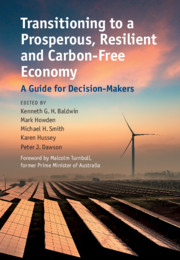Book contents
- Transitioning to a Prosperous, Resilient and Carbon-Free Economy
- Transitioning to a Prosperous, Resilient and Carbon-Free Economy
- Copyright page
- Dedication
- Contents
- Figures
- Tables
- Contributors
- Foreword
- Introduction
- 1 Policy Frameworks and Institutions for Decarbonisation: The Energy Sector as ‘Litmus Test’
- Technologies for Decarbonising the Electricity Sector
- Example Economies
- Cities and Industry
- 11 Cities
- 12 Buildings and Precincts
- 13 Urban Water
- 14 National Climate Change Adaptation Case Study: Early Adaptation to Climate Change through Climate-Compatible Development and Adaptation Pathways
- 15 Transport
- 16 Industry and Manufacturing
- Land Use, Forests and Agriculture
- Mining, Metals, Oil and Gas
- Addressing Barriers io Change
- Index
- References
12 - Buildings and Precincts
from Cities and Industry
Published online by Cambridge University Press: 08 October 2021
- Transitioning to a Prosperous, Resilient and Carbon-Free Economy
- Transitioning to a Prosperous, Resilient and Carbon-Free Economy
- Copyright page
- Dedication
- Contents
- Figures
- Tables
- Contributors
- Foreword
- Introduction
- 1 Policy Frameworks and Institutions for Decarbonisation: The Energy Sector as ‘Litmus Test’
- Technologies for Decarbonising the Electricity Sector
- Example Economies
- Cities and Industry
- 11 Cities
- 12 Buildings and Precincts
- 13 Urban Water
- 14 National Climate Change Adaptation Case Study: Early Adaptation to Climate Change through Climate-Compatible Development and Adaptation Pathways
- 15 Transport
- 16 Industry and Manufacturing
- Land Use, Forests and Agriculture
- Mining, Metals, Oil and Gas
- Addressing Barriers io Change
- Index
- References
Summary
This chapter outlines the case for the global green building movement to embrace integrated ‘climate-smart’ green building design, construction and operation, which optimises new and existing buildings to achieve both mitigation and adaptation goals synergistically and cost-effectively. The climate-smart building agenda is a high priority for this sector because it can help improve the well-being, productivity and health of occupants, and provide other social equity benefits, thus helping, simultaneously, to achieve other UN Sustainable Development Goals. Focus extends to precincts, the building blocks of cities, interfacing Building and Precinct Information Modelling. Overview is provided of leading sustainability assessment and rating tools for design of buildings and precincts. The chapter identifies key stakeholders and decision makers, and how each can best play their part to enable needed changes in this sector to achieve a net zero-carbon resilient future. It examines the role of governments in addressing major market and informational failures and what policies are needed to underpin efforts by all these key actors to achieve decarbonisation of the built environment sector.
Keywords
- Type
- Chapter
- Information
- Transitioning to a Prosperous, Resilient and Carbon-Free EconomyA Guide for Decision-Makers, pp. 301 - 337Publisher: Cambridge University PressPrint publication year: 2021



